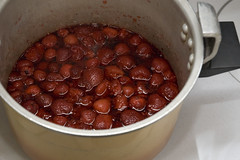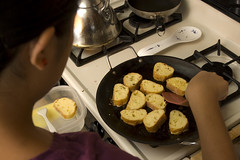
One of my favorite desserts is crème brûlée, literally "burnt cream" in French. This 500 year old dessert is definitely not an ideal healthy quick dish for college students, but its a great way to impress friends with a expensive sounding dish.
My dad usually buys prepared crème brûlée from the supermarket. Over the last couple of years, he's accumulated over 3 dozen ramekins - the dishes crème brûlée is baked in. Since he's running out of space for dishes, I thought I would try making the dessert from scratch, and reusing the ramekins. If you do not have ramekins, there are often some hanging out in thrift stores. Any oven-safe shallow bowl will do.
This recipe is from cross referencing different sources online.
Crème Brûlée (three ramekins)
Ingredients
+ 2 cups heavy cream (or 1 cup milk, 1 cup heavy cream for less richness)
+ 1 ts vanilla extract (optional)
+ 3 egg yolks
+ 1/2 cup granulated sugar
+ 3 ramekins
+ deep baking dish
PreperationStart heating the cream in a pot over the stove. *Turn off the stove when the cream starts boiling, and let it hang out for 10 minutes.* While it begins heating, mix the three egg yolks and the sugar in a bowl, mixing long enough to incorporate a little air. The mixture should lighten in color a little bit. (In the photo, notice the different in color between the beaten mixture and the yolk on the side of the bowl). If you have vanilla, add it into the egg mixture.
While the cream cools, preheat the oven to 325 degrees, slowly add it to the egg mixture while stirring continuously. Now, split this mixture between three ramekins (I was able to make 3.5, but it depends on the size of your ramekins). Here's the tricky part- put the ramekins in the deep baking dish, then add water to the dish until the water level lies a little under the tops of the ramekins. (I used bigger ramekins for each ramekin, but the principle is the same.) Now shove them in the oven around forty minutes so that theyset. Check on them often. They're ready when a fork comes out clean when you stick it an inch from the edge of the ramekin. They will still be jiggly. Mine had a few brown spots, but were mostly uniform. Let them cool off outside the oven, then refrigerate them. They take 20 minutes to prepare before serving. They last about 2 days in the fridge. Freezing them will let them last longer.
Serving
I'll assume you dont have a torch to caramelize the sugar. Sprinkle less than a tablespoon of sugar over the top of each ramekin. Broil them on the oven. Within a few minutes, the sugar will melt and caramalize. Check often, and pull them out when the sugar has been boiling for 3-4 minutes, or when the top is browning. Pull them out, let them cool off for five minutes before serving.

 I have a lot of support cooking from my friends and family. However, a steady influence and motivation for cooking comes from my partner in crime, Melissa Galinato. She's a brilliant undergrad at UCSD, majoring in human biology. She, too, suffers from too much work and not enough time, but still finds enough to cook a few times a week. Coincidentally, we've been a couple for almost two years.
I have a lot of support cooking from my friends and family. However, a steady influence and motivation for cooking comes from my partner in crime, Melissa Galinato. She's a brilliant undergrad at UCSD, majoring in human biology. She, too, suffers from too much work and not enough time, but still finds enough to cook a few times a week. Coincidentally, we've been a couple for almost two years.







 As a freshman, my food came from the college all-you-care-to-eat commons. I took food for granted, and the process through which the ingredients went through before landing on my plate - from farming to transport to preparation - remained hidden behind a fog of apathy.
As a freshman, my food came from the college all-you-care-to-eat commons. I took food for granted, and the process through which the ingredients went through before landing on my plate - from farming to transport to preparation - remained hidden behind a fog of apathy.